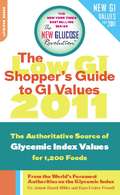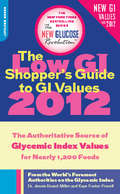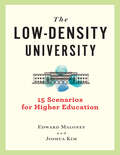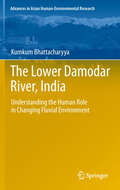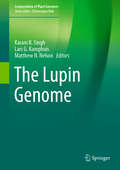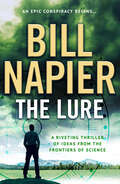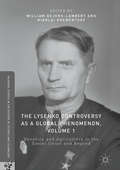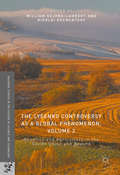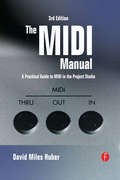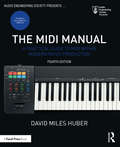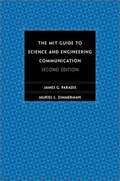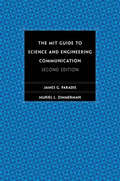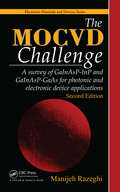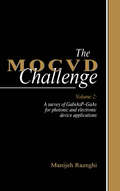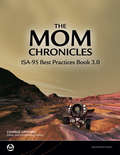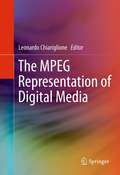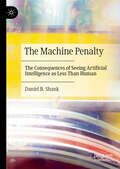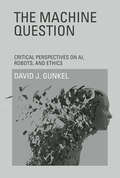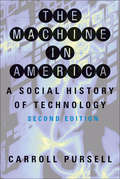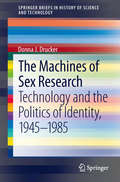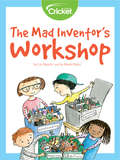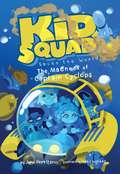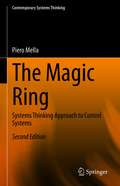- Table View
- List View
The Low GI Shopper's Guide to GI Values 2011
by Kaye Foster-Powell Jennie Brand-Miller M. Nutri. DietAlongside growing scientific evidence supporting the remarkable health benefit of a low-GI diet and the forthcoming publication of the revised Low GI Handbook (previously published as The New Glucose Revolution, more than 1 million copies sold in all editions), a new audience is poised to discover the Shopper’s Guide and its comprehensive lists of GI values-the key to unlocking those benefits. Shopper’s Guide is the only annually updated book of GI values, featuring up-to-date comprehensive nutritional data on nearly 1,500 foods, with additional information for those following gluten-free diets, shopping lists, and tips for meal planning and dining out. The convenient at-a-glance tables make this the necessary guide for people following the glycemic index to manage conditions such as diabetes, heart disease, or PCOS; to lose weight; or to improve their overall well-being.
The Low GI Shopper's Guide to GI Values 2012
by Dr Jennie Brand-Miller Kaye Foster-Powell M. Nutri. DietWhether you’re grocery shopping, planning dinner, eating out, or meeting with your nutritionist or dietitian, the seventh annual edition of the Shopper’s Guide to GI Values—previous editions of which have sold more than 180,000 copies—is a must for anyone seeking healthier eating habits. Newly revised and updated, the convenient, at-a-glance tables make this the one necessary guide for people following a glycemic index (GI) diet to improve health conditions such as diabetes, heart disease, or PCOS; lose weight; or enhance their overall well-being and fitness. Shopper’s Guide is the only annually updated book of GI values, featuring nearly 1,300 foods and their GI values as well as comprehensive nutritional data for calories, fat, saturated fat, cholesterol, fiber, and sodium.
The Low-Density University: 15 Scenarios for Higher Education
by Joshua Kim Edward J. MaloneyCOVID-19 has placed American higher education at a crossroads. This book is the roadmap.COVID-19 triggered an existential crisis for American higher education. Faced with few safe choices, most colleges and universities switched to remote learning during the 2020 spring semester. The future, however, provides more choices about how institutions can fulfill their mission of teaching and research. But how do we begin to make decisions in an uncertain and shifting environment? In this concise guide, authors Edward J. Maloney and Joshua Kim lay out clear ways colleges and universities can move forward in safe and effective ways.The Low-Density University presents fifteen scenarios for how colleges and universities can address the current crisis from a fully online semester to others with students in residence and in the classroom. How can changing the calendar or shifting to hybrid models of blended classrooms impact teaching, learning, and the college experience? Could we emerge from this crisis with new models that are better and more adapted to today's world? The Low-Density University focuses primarily on teaching and learning, but student life (housing, athletics, health, etc.) are core to the college experience. Can we devise safe and effective ways to preserve the best of that experience? The lessons here extend beyond the classroom. Just as the pandemic will change American higher education, the choices we make now will change what college looks like for generations to come.
The Lower Damodar River, India
by Kumkum BhattacharyyaInterweaving the human aspects of river control with analysis of hydro-physical data, including historical data over the last few centuries, this monograph is a comprehensive evaluation of the Damodar's lower reaches. While the Damodar River isn't an exceptional tropical river, nor does it feature classic examples of river control structures, it is unusual and worthy of study due to the fact that nowhere else in the tropical world have riverine sandbars been used as a resource base as well as for permanent settlements. Based on their knowledge of river stages, the inhabitants have fine-tuned their land use to flood events, applying a concept of flood zoning to the riverbed. Every available space has been utilized rationally and judiciously. This rare human-environmental study analyzes the remarkable way in which immigrants unfamiliar with the riverine environment have adapted to the altered hydrologic regime of the river. In doing so they have demonstrated a sophisticated understanding of the flood regime and the vagaries of an unpromising environment in their land use, cropping and settlement patterns. Spurred on by restricted social and economic mobility and sometimes political constraints, these self-settled refugees have learned to adapt to their environment and live with the floods. Bhattacharyya's text is particularly timely, as anthropogenic processes of this kind have not been adequately studied by geographers.
The Luftwaffe (The Epic of Flight)
by Time-Life BooksIn March 1935, only two years after he came to power in Germany, Adolf Hitler openly defied the Treaty of Versailles imposed on his country at the end of World War I and announced a massive program of rearmament. The plan called for a Reichsluftwaffe, a national air force whose squadrons, as Nazi propagandists said, would put a "steel roof over Germany" and "darken out the sun."
The Lupin Genome (Compendium of Plant Genomes)
by Karam B. Singh Lars G. Kamphuis Matthew N. NelsonThis book on lupin genomics primarily focuses on the narrow-leafed lupin (NLL), and details the genomic resources that have been developed and how they are currently being used to help advance both fundamental and applied research on NLL in areas ranging from its domestication to plant–microbe interactions and syntenic relationships between NLL and other legume crops. It also reports on genomic efforts being pursued with regard to other lupin crops.Lupins are important ecological ‘engineers’: they can colonise and thrive in low-nutrient soils due to their ability to fix atmospheric nitrogen in symbiosis with bacteria and efficiently take up phosphorous. Recently, lupins have attracted considerable interest, not only because of their value for sustainable farming as a break crop, but also as a potential ‘super food’ for fighting major health issues in connection with diabetes and obesity.Narrow-leafed lupin is the main grain legume crop, grown primarily in Australia, and was therefore selected for the development of a reference lupin genome and associated genomic resources. Its genome has recently been sequenced with a focus on the gene-rich space, which has advanced the development of new breeding tools for the improvement of NLL and related lupin crops.
The Lure
by Bill NapierIn this thriller from an author who &“deftly mix[es] history, science and science fiction,&” researchers discover alien life and global conspiracy (Publishers Weekly). A signal from space, a conspiracy on Earth. An underground research station in Eastern Europe is suddenly bombarded with rhythmic bursts of subnuclear particles from beyond Earth—a pattern so complex it can only come from a highly evolved intelligence. As the messages are decoded, the scientists are amazed by the information they reveal: secrets of a technology far in advance of our own, suggesting that a benign civilization wishes to share knowledge with humankind. Surely, the scientists argue, the signal should be acknowledged? But the world&’s superpowers have other ideas, and suddenly the scientists find themselves at the heart of a global conspiracy . . .The Lure is an extraordinary and original thriller, perfect for fans of Scott Mariani, Dan Brown and Clive Cussler. Praise for the writing of Bill Napier: &“Fans of Dan Brown take note.&” —Jack DuBrul, New York Times–bestselling author of the Philip Mercer series &“The most exciting book I have ever read.&” —Arthur C. Clarke, New York Times–bestselling author of 2001: A Space Odyssey &“Fans of Michael Crichton will find a kindred spirit in Napier.&” –Publishers Weekly
The Lysenko Controversy as a Global Phenomenon, Volume 1
by William Dejong-Lambert Nikolai KrementsovThis volume covers the global history of the Lysenko controversy, while exploring in greater depth the background of D. Lysenko's career and influence in the USSR. By presenting the rise and fall of T. D. Lysenko in a variety of aspects--his influence upon art, unrecognized predecessors, and the extent to which genetics continued in the USSR even while he was in power, and the revival of his reputation today--the authors provide a fresh perspective on one of the most notorious episodes in the history of science.
The Lysenko Controversy as a Global Phenomenon, Volume 2
by William Dejong-Lambert Nikolai KrementsovThis volume examines the international impact of Lysenkoism in its namesake's heyday and the reasons behind Lysenko's rehabilitation in Russia today. By presenting the rise and fall of T. D. Lysenko in its various aspects, the authors provide a fresh perspective on one of the most notorious episodes in the history of science.
The MIDI Manual: A Practical Guide to MIDI in the Project Studio (Audio Engineering Society Presents Ser.)
by David Miles HuberThe MIDI Manual is a complete reference on MIDI, written by a well-respected sound engineer and author. This best-selling guide provides a clear explanation of what MIDI is, how to use electronic instruments and an explanation of sequencers and how to use them. You will learn how to set up an efficient MIDI system and how to get the best out of your music. The MIDI Manual is packed full of useful tips and practical examples on sequencing and mixing techniques. It also covers editors/librarians, working with a score, MIDI in mass media and multimedia and synchronisation. The MIDI spec is set out in detail along with the helpful guidelines on using the implementation chart. Illustrated throughout with helpful photos and screengrabs, this is the most readable and clear book on MIDI available.
The MIDI Manual: A Practical Guide to MIDI within Modern Music Production (Audio Engineering Society Presents)
by David Miles HuberThe MIDI Manual: A Practical Guide to MIDI within Modern Music Production, Fourth Edition, is a complete reference on MIDI. Written by David Miles Huber (a 4x Grammy-nominated musician, producer and author), this best-selling guide provides clear explanations of what MIDI 1.0 and 2.0 are, acting as a guide for electronic instruments, the DAW, MIDI sequencing and how to make best use of them. You will learn how to set up an efficient MIDI system and how to get the most out of your production room and ultimately … your music. Packed full of useful tips and practical examples on sequencing and mixing techniques, The MIDI Manual also covers in-depth information on system interconnections, controllers, groove tools, the DAW, synchronization and more. For the first time, the MIDI 2.0 spec is explained in light of the latest developments and is accompanied with helpful guidelines for the long-established MIDI 1.0 spec and its implementation chart. Illustrated throughout with helpful photos and screenshots, this is the most readable and clearly explained book on MIDI available.
The MIT Guide to Science and Engineering Communication (Second Edition)
by James G. Paradis Muriel L. ZimmermanThis guide covers the basics of scientific and engineering communication, including defining an audience, working with collaborators, searching the literature, organizing and drafting documents, developing graphics, and documenting sources.
The MIT Guide to Science and Engineering Communication, second edition
by James Paradis Muriel ZimmermanA second edition of a popular guide to scientific and technical communication, updated to reflect recent changes in computer technology.This guide covers the basics of scientific and engineering communication, including defining an audience, working with collaborators, searching the literature, organizing and drafting documents, developing graphics, and documenting sources. The documents covered include memos, letters, proposals, progress reports, other types of reports, journal articles, oral presentations, instructions, and CVs and resumes. Throughout, the authors provide realistic examples from actual documents and situations. The materials, drawn from the authors' experience teaching scientific and technical communication, bridge the gap between the university novice and the seasoned professional. In the five years since the first edition was published, communication practices have been transformed by computer technology. Today, most correspondence is transmitted electronically, proposals are submitted online, reports are distributed to clients through intranets, journal articles are written for electronic transmission, and conference presentations are posted on the Web. Every chapter of the book reflects these changes. The second edition also includes a compact Handbook of Style and Usage that provides guidelines for sentence and paragraph structure, punctuation, and usage and presents many examples of strategies for improved style.
The MOCVD Challenge: A survey of GaInAsP-InP and GaInAsP-GaAs for photonic and electronic device applications, Second Edition (Electronic Materials and Devices Series)
by Manijeh RazeghiNow in its second edition, this updated, combined volume provides a survey of GaInAsP-InP and GaInAsP-GaAs related materials for electronic and photonic device applications. It begins with an introduction to semiconductor compounds and the MOCVD growth process. It then discusses in situ and ex situ characterization techniques for MOCVD growth. Next, the book examines the specifics of the growth of GaAs and the growth and characterization of the GaAs-GaInP system. It describes optical devices based on GaAs and related compounds and details the specifics of GaAs-based laser diode structures. It also discusses electronic devices and provides an overview of optoelectronic integrated circuits (OEICs). It then reviews InP-InP and GaInAs(P)-InP MO
The MOCVD Challenge: Volume 2: A Survey of GaInAsP-GaAs for Photonic and Electronic Device Applications
by Manijeh RazeghiThe MOCVD Challenge: Volume 2, A Survey of GaInAsP-GaAs for Photonic and Electronic Device Applications focuses on GaAs systems and devices grown by MOCVD, specifically MOCVD growth of GaAs and related alloys and GaInP for photonic and electronic applications. Along with Volume 1, this book provides a personal account of the author's own pioneering
The MOM Chronicles ISA-95 Best Practices Book 3.0
by Charlie GiffordSpringing from the international success of Books 1.0 and 2.0, the ISA-chartered ISA-95 Best Practices Working Group, chaired by Charlie Gifford, brings out its third collection of Manufacturing Operations Management (MOM) methodology white papers. The Book 3.0 collection focuses on MOM system engineering to organize the complex 21st-century manufacturing plant and to optimize its role in a global supply chain. The methods do not trivialize the complexities as simply equipment optimization or material quality or consumption problems. In the twenty-year evolution of computerized manufacturing solutions, most manufacturers primarily applied and still apply point solutions to department issues. Book 3.0 explains how to develop an overall operations process definition. This definition determines operations dependencies for the entire plant in the supply network. The operations process definition as the MOM Master User Requirement Specification maps out the "As-Is" inefficient operations and the "To-Be" reengineered efficient operations. Current leaders and managers of most manufacturers have a very limited vision of how their plants must operate in the global market in five or ten years to be competitive in 2020-2025. Today's manufacturing managers generally do not have a concept of the total engineering cost to transform their paper-based operations into real-time manufacturing using artificial intelligence for their work processes. The proven reality of manufacturing operations is that manufacturing innovation requires an iterative continuous improvement process through MOM systems engineering. This requires leaders to accept innovation with managed risk to move manufacturing operations technologies forward. Operations intelligence is high-risk innovation. Period. But by 2025, those manufacturers who have not adopted paperless processes for intelligent operations will simply not be able to compete globally and will fail in business. Book 3.0 lays out the foundation to succeed.
The MPEG Representation of Digital Media
by Leonardo ChiariglioneMore and more information, audio and video but also a range of other information type, is generated, processed and used by machines today, even though the end user may be a human. The result over the past 15 years has been a substantial increase in the type of information and change in the way humans generate, classify, store, search, access and consume information. Conversion of information to digital form is a prerequisite for this enhanced machine role, but must be done having in mind requirements such as compactness, fidelity, interpretability etc. This book presents new ways of dealing with digital information and new types of digital information underpinning the evolution of society and business.
The Machine Penalty: The Consequences of Seeing Artificial Intelligence as Less Than Human
by Daniel B. ShankThis book makes the argument that comparing AI to humans leads us to diminish similar outcomes from AI across situations. This may be taking a human&’s advice for a restaurant recommendation over an AI&’s or believing that AI can&’t be as biased as people can when denying loans to others. This machine penalty is caused both by comparing humans and AI in terms of appearance, identity, behavior, mind, and essence, and by situations involving controllable, personal, important, subjective, or moral decisions. It can be applied across many different situations, where we diminish different AI outcomes. We penalize machines&’ influence when they give advice, fairness when they evaluate people, blame when they cause harm, value when they produce art, and satisfaction when they provide companionship. The result is immediate consequences in those domains and downstream consequences for society. This monograph brings together diverse research from human-computer interaction, psychology, sociology, and communication including theories such as Computers Are Social Actors, anthropomorphism, mind perception, and algorithm aversion to present an expansive argument and evidence for the machine penalty.
The Machine Question: Critical Perspectives on AI, Robots, and Ethics (The\mit Press Ser.)
by David J. GunkelAn investigation into the assignment of moral responsibilities and rights to intelligent and autonomous machines of our own making.One of the enduring concerns of moral philosophy is deciding who or what is deserving of ethical consideration. Much recent attention has been devoted to the "animal question"—consideration of the moral status of nonhuman animals. In this book, David Gunkel takes up the "machine question": whether and to what extent intelligent and autonomous machines of our own making can be considered to have legitimate moral responsibilities and any legitimate claim to moral consideration.The machine question poses a fundamental challenge to moral thinking, questioning the traditional philosophical conceptualization of technology as a tool or instrument to be used by human agents. Gunkel begins by addressing the question of machine moral agency: whether a machine might be considered a legitimate moral agent that could be held responsible for decisions and actions. He then approaches the machine question from the other side, considering whether a machine might be a moral patient due legitimate moral consideration. Finally, Gunkel considers some recent innovations in moral philosophy and critical theory that complicate the machine question, deconstructing the binary agent–patient opposition itself.Technological advances may prompt us to wonder if the science fiction of computers and robots whose actions affect their human companions (think of HAL in 2001: A Space Odyssey) could become science fact. Gunkel's argument promises to influence future considerations of ethics, ourselves, and the other entities who inhabit this world.
The Machine in America: A Social History of Technology
by Carroll Pursell2008 Outstanding Academic Title, Choice MagazineFrom the medieval farm implements used by the first colonists to the invisible links of the Internet, the history of technology in America is a history of society as well. Arguing that "the tools and processes we use are a part of our lives, not simply instruments of our purpose," historian Carroll Pursell analyzes technology's impact on the lives of women and men, on their work, politics, and social relationships—and how, in turn, people influence technological development.Pursell shows how both the idea of progress and the mechanical means to harness the forces of nature developed and changed as they were brought from the Old World to the New. He describes the ways in which American industrial and agricultural technology began to take on a distinctive shape as it adapted and extended the technical base of the industrial revolution. He discusses the innovation of an American system of manufactures and the mechanization of agriculture; new systems of mining, lumbering, and farming, which helped conquer and define the West; and the technologies that shaped the rise of cities. In the second edition of The Machine in America, Pursell brings this classic history up to date with a revised chapter on war technology and new discussions on information technology, globalization, and the environment.
The Machines of Sex Research: Technology and the Politics of Identity, 1945-1985
by Donna J. DruckerThe Machines of Sex Research describes how researchers worldwide integrated technology into studies of human sexuality in the postwar era. The machines they invented made new ways of seeing bodies possible. Some researchers who studied men used machines like penile strain gauges to police "deviant" male sexuality; others used less painful devices like penis-cameras to study women's sexual responses and map the physiology of their arousal and orgasm. While researchers used the findings from their technological innovations to propose their own views of how people should view their bodies and should manage their sexual lives, their readers interpreted their findings to enact their own visions of sexuality. Drucker shows how the use of machines in sex research provided some of the intellectual underpinnings of the sexual revolution and the women's and gay rights movements, and in turn how the sex research community developed new machines for investigations that would enhance sexual happiness rather than constrict it. The Machines of Sex Research is a key read for those interested in the intersections between human sexuality, technology, and twentieth-century social movements. Describes the little-known history of the machines of human sex research in the postwar era Shows how researchers worldwide invented and used machines to study human sexuality and the body in new ways, and how they used and improved each other's designs Relates the relationship between the machines of sex research to Cold War sexualities and gender and sexual liberation movements.
The Mad Inventor's Workshop
by Liz HuyckInventing is all about ideas—ideas for making products better or creating new ones. To put these ideas into action, young inventors need tools for tinkering. Find out how to put together your own inventor's workshop with simple tools and common household objects.
The Madness of Captain Cyclops (Kid Squad Saves The World)
by John PerritanoWhen the testing of a nuclear-powered invisibility device goes awry, Captain Rudolph Von Dorn is transformed into the evil Captain Cyclops, blowing up ships and islands at will—and the Kid Squad, with the help of Von Dorn’s daughter Jenny, is called upon to reverse the effects of the accident and save the world.
The Magic Fan
by Keith BakerGuided by a magic fan, Yoshi builds a boat to catch the moon, a kite to reach the clouds, and a bridge that saves the villagers from a tidal wave.
The Magic Ring: Systems Thinking Approach to Control Systems (Contemporary Systems Thinking)
by Piero MellaThis book presents a new understanding on how control systems truly operate, and explains how to recognize, simulate, and improve control systems in all fields of activity. It also reveals the pervasive, ubiquitous and indispensable role of control processes in our life and the need to develop a “control-oriented thinking”—based on uncomplicated but effective models derived from systems thinking—that is, a true “discipline of control.” Over the book’s thirteen chapters, Piero Mella shows that there are simple control systems (rather than complex ones) that can easily help us to manage complexity without drawing upon more sophisticated control systems. It begins by reviewing the basic language of systems thinking and the models it allows users to create. It then introduces the control process, presenting the theoretical structure of three simple control systems we all can observe in order to gain fundamental knowledge from them about the basic structure of a control system. Then, it presents the anatomy of the simplest “magic ring” and the general theoretical model of any control system. This is followed by an introduction to a general typology of control systems and a broader view of control systems by investigating multi-lever control systems and multi-objective systems. The book undertakes the concepts through various environments, increasingly broader in scope to suggest to readers how to recognize therein control systems manifestations in everyday life and in natural phenomena. Updated for the 2nd edition, new chapters explore control systems regulating the biological environment and the organizations, with an in-depth study of the control of quality, productivity, production, stocks and costs. Finally, it concludes by dealing with the learning process, problem-solving, and designing the logical structure of control systems.
